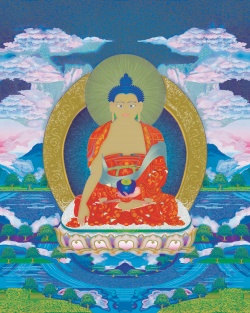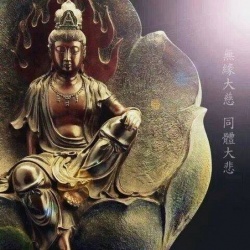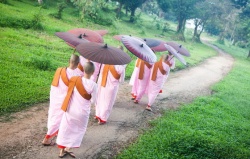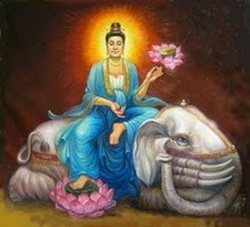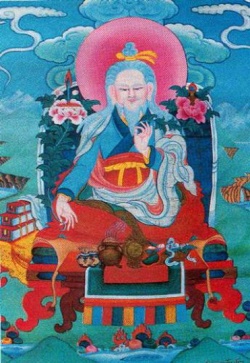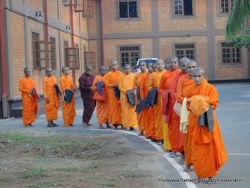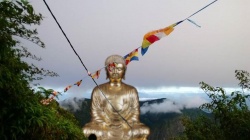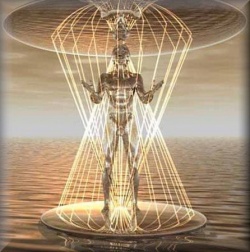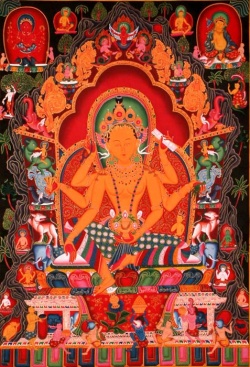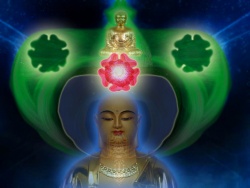Difference between revisions of "About Tibetan Astrology"
(Created page with " <poem> What is Tibetan Astrology? The Tibetan astrological {{Wiki|sciences}} can be classified into two categories: {{Wiki|astronomy}} (skar-rtsis) and...") |
|||
| Line 1: | Line 1: | ||
| − | + | <nomobile>{{DisplayImages|906|3983|2859|1327|464|3414|2867|2333|3256|560|1554|2536|775|3143|4069}}</nomobile> | |
| Line 11: | Line 11: | ||
The [[Tibetan]] [[astrological]] {{Wiki|sciences}} can be classified into two categories: {{Wiki|astronomy}} ([[skar-rtsis]]) and [[elemental astrology]] ('[[byung-rtsis]]). Both [[skar-rtsis]] and 'byung-rtsi have drawn from the teachings of countries such as [[India]], [[Persia]] and {{Wiki|Greece}}, as well as [[Buddhism]], to create a uniquely [[Tibetan]] system of {{Wiki|astronomy}} and [[astrology]]. | The [[Tibetan]] [[astrological]] {{Wiki|sciences}} can be classified into two categories: {{Wiki|astronomy}} ([[skar-rtsis]]) and [[elemental astrology]] ('[[byung-rtsis]]). Both [[skar-rtsis]] and 'byung-rtsi have drawn from the teachings of countries such as [[India]], [[Persia]] and {{Wiki|Greece}}, as well as [[Buddhism]], to create a uniquely [[Tibetan]] system of {{Wiki|astronomy}} and [[astrology]]. | ||
| − | [[Tibetan]] [[elemental astrology]], '[[byung-rtsis]], which draws from Classical [[Elemental Astrology]], is the [[ancient]] [[art]] of calculation and [[interpretation]] of [[celestial]] [[phenomena]]. | + | [[Tibetan]] [[elemental astrology]], '[[byung-rtsis]], which draws from Classical [[Elemental Astrology]], is the [[ancient]] [[art]] of calculation and [[interpretation]] of [[celestial]] [[phenomena]]. |
| + | |||
| + | [[Classical Elemental Astrology]] [[nag-rtsis]] is based on the [[five elements]], the twelve year cycle, eight [[par-kha]] or [[Wikipedia:ba gua|trigrams]], and nine [[sme-wa]] or [[magic]] square numbers. | ||
| + | |||
| + | [[Tibetan]] [[astrologers]] use these to calculate [[horoscopes]] along four major themes: one's [[life span]], [[physical]] [[condition]], economic and {{Wiki|political}} power, and overall [[luck]] in business and work. | ||
The [[Tibetan]] system of {{Wiki|astronomy}}, [[skar-rtsis]], draws from the [[Shri Kalachakra]] [[Tantra]] and the [[Arising Vowel System]], dbyangs-char, which assigns a different {{Wiki|vowel}} to each of the days of the month, and calculates its effect on {{Wiki|individuals}} and nations. | The [[Tibetan]] system of {{Wiki|astronomy}}, [[skar-rtsis]], draws from the [[Shri Kalachakra]] [[Tantra]] and the [[Arising Vowel System]], dbyangs-char, which assigns a different {{Wiki|vowel}} to each of the days of the month, and calculates its effect on {{Wiki|individuals}} and nations. | ||
| − | There are parallels between [[Tibetan]] and [[Vedic astrology]] in their calculation of calendars and {{Wiki|planetary}} {{Wiki|movement}}. Although the [[Tibetan]] and [[Indian]] calendars start the year on different dates, they are similar in their use of the twelve {{Wiki|zodiac}} houses and the five {{Wiki|planets}} {{Wiki|Mars}}, {{Wiki|Mercury}}, {{Wiki|Jupiter}}, [[Venus]] and {{Wiki|Saturn}}. (The outer {{Wiki|planets}} are not recognised, as they had not been discovered at the time the [[ancient]] texts were written.) Like [[Vedic astrology]], [[Tibetan astrology]] recognises the shadowy {{Wiki|planets}} of [[Rahu]] and [[Wikipedia:Ketu (mythology)|Ketu]], which are important for the {{Wiki|prediction}} of {{Wiki|eclipses}} and well-being. | + | |
| + | There are parallels between [[Tibetan]] and [[Vedic astrology]] in their calculation of calendars and {{Wiki|planetary}} {{Wiki|movement}}. | ||
| + | |||
| + | Although the [[Tibetan]] and [[Indian]] calendars start the year on different dates, they are similar in their use of the twelve {{Wiki|zodiac}} houses and the five {{Wiki|planets}} {{Wiki|Mars}}, {{Wiki|Mercury}}, {{Wiki|Jupiter}}, [[Venus]] and {{Wiki|Saturn}}. | ||
| + | |||
| + | (The outer {{Wiki|planets}} are not recognised, as they had not been discovered at the time the [[ancient]] texts were written.) Like [[Vedic astrology]], [[Tibetan astrology]] recognises the shadowy {{Wiki|planets}} of [[Rahu]] and [[Wikipedia:Ketu (mythology)|Ketu]], which are important for the {{Wiki|prediction}} of {{Wiki|eclipses}} and well-being. | ||
| + | |||
| + | |||
The role of the [[TIBETAN]] ASTROLOGER | The role of the [[TIBETAN]] ASTROLOGER | ||
| − | |||
| − | |||
| − | In a situation where a {{Wiki|disease}} is considered to be [[karmic]] - i. e. the result of [[spirits]] or [[negative karma]] - an antidote may be drawn up by either an [[astrologer]] or [[lama]]. The [[astrologer]] determines which [[spirits]] are afflicting the {{Wiki|patient}}, the type of {{Wiki|disease}} it has produced, and the [[prayer]] that is needed to appease the [[spirit]]. Alternatively, the [[astrologer]] may aid the {{Wiki|patient}} by determining which doctor and system of [[medicine]] is most appropriate to treat the ailment. | + | The [[Tibetan]] [[astrologer]] plays an important and active role in the [[Tibetan]] {{Wiki|community}}, especially during times of [[births]], [[deaths]], marriages and prolonged [[illnesses]]. |
| + | |||
| + | When a child is born, [[Tibetan]] [[parents]] often consult an [[astrologer]] to learn of the child's {{Wiki|future}}. | ||
| + | |||
| + | The [[astrologer]] constructs a [[birth]] chart which includes predictions about the child's [[education]], likely {{Wiki|occupation}}, and whether the child should be encouraged to undertake [[monastic]] studies. If the [[birth]] chart predictions are unfavourable, an antidote, often in the [[form]] of a [[prayer]], is prescribed. | ||
| + | |||
| + | In other situations, the [[parents]] may be asked to make a donation to the poor and needy. If the [[life]] of the child is in [[danger]], a preventative measure may be taken by saving the [[life]] of an [[animal]] that is about to be slaughtered. | ||
| + | |||
| + | |||
| + | |||
| + | Before marrying, the [[parents]] of either the bride or groom may approach an [[astrologer]] to draw up a [[marriage]] chart. Which [[parents]] approach the [[astrologer]] depends on which household the couple will live in after marrying. | ||
| + | |||
| + | The [[marriage]] chart includes predictions based on the couple's [[life span]], standard of living, and [[luck]]. In more detailed [[marriage]] charts, a {{Wiki|prediction}} is made of the number of children the mother will bear, and which partner will have more influence over the running of the house. | ||
| + | |||
| + | In the case that any of these predictions are unfavourable, the [[astrologer]] will prepare an [[amulet]] for either partner, or, in [[exceptional]] circumstances, for both partners. | ||
| + | |||
| + | Alternatively, the couple may be asked to make a donation of clothing to a [[lama]] or [[monastery]] or recite a special [[prayer]]. | ||
| + | |||
| + | |||
| + | In a situation where a {{Wiki|disease}} is considered to be [[karmic]] - i. e. the result of [[spirits]] or [[negative karma]] - an antidote may be drawn up by either an [[astrologer]] or [[lama]]. | ||
| + | |||
| + | The [[astrologer]] determines which [[spirits]] are afflicting the {{Wiki|patient}}, the type of {{Wiki|disease}} it has produced, and the [[prayer]] that is needed to appease the [[spirit]]. | ||
| + | |||
| + | Alternatively, the [[astrologer]] may aid the {{Wiki|patient}} by determining which doctor and system of [[medicine]] is most appropriate to treat the ailment. | ||
| + | |||
| + | |||
| + | |||
| + | An [[astrologer]] also plays an important role in the {{Wiki|community}} near the time of [[death]]. | ||
| + | |||
| + | At this point, an [[astrologer]] is often called on to determine whether the dying [[person]] has any [[life]] left in her/his [[body]]. | ||
| + | |||
| + | |||
| + | To avoid bad [[spirits]] after the person's [[death]], the [[astrologer]] determines who can and cannot {{Wiki|touch}} the [[body]], on which day the [[body]] should be moved, and which [[prayers]] the [[family]] of the deceased should make. | ||
| + | |||
| + | The [[astrologer]] may also be called on at other times, such as when a [[person]] is moving house or beginning an important journey or {{Wiki|undertaking}} in her/his [[life]]. | ||
| + | |||
| + | In this way, [[Tibetan]] [[astrologers]] continue to occupy an important role in the [[Tibetan]] {{Wiki|community}} in much the same way they have for thousands of years. | ||
| + | |||
| − | |||
History of [[TIBETAN]] ASTROLOGY | History of [[TIBETAN]] ASTROLOGY | ||
| + | |||
| + | |||
2nd century B.C. - 4th century A.D. | 2nd century B.C. - 4th century A.D. | ||
| − | Until the introduction of [[Buddhism in Tibet]] in the fourth century A.D., the [[Bon religion]] formed the basis of [[Tibetan astrology]]. Its [[doctrines]] are presented in a detailed system of categories and sub-categories, two of which are [[astrology]] and [[medicine]]. The [[Bon]] [[doctrines]] [[acknowledge]] the [[five elements]] of [[Wood]], [[Fire]], [[Earth]], Metal and [[Water]], and use a system of [[astrological]] {{Wiki|prediction}} and {{Wiki|divination}} similar to [[shamanism]]. | + | |
| + | |||
| + | Until the introduction of [[Buddhism in Tibet]] in the fourth century A.D., the [[Bon religion]] formed the basis of [[Tibetan astrology]]. | ||
| + | |||
| + | Its [[doctrines]] are presented in a detailed system of categories and sub-categories, two of which are [[astrology]] and [[medicine]]. | ||
| + | |||
| + | The [[Bon]] [[doctrines]] [[acknowledge]] the [[five elements]] of [[Wood]], [[Fire]], [[Earth]], Metal and [[Water]], and use a system of [[astrological]] {{Wiki|prediction}} and {{Wiki|divination}} similar to [[shamanism]]. | ||
| + | |||
| + | |||
6th century A.D. | 6th century A.D. | ||
| − | The [[Tibetan King]] [[Namri Songtsen]] sends four of [[Tibet's]] most brilliant young [[scholars]] to [[China]] to study [[astrology]]. On their return, the four introduce invaluable [[information]] to [[Tibetan astrology]]. However, there being no written [[language]] of [[Tibet]] at the time, the [[information]] is only conveyed orally. | + | |
| + | |||
| + | The [[Tibetan King]] [[Namri Songtsen]] sends four of [[Tibet's]] most brilliant young [[scholars]] to [[China]] to study [[astrology]]. On their return, the four introduce invaluable [[information]] to [[Tibetan astrology]]. | ||
| + | |||
| + | However, there being no written [[language]] of [[Tibet]] at the time, the [[information]] is only conveyed orally. | ||
| + | |||
7th century A.D. | 7th century A.D. | ||
The fifth wife of the [[Tibetan King]] [[Songtsen Gampo]], [[Kong Ju]], an accomplished [[astrologer]], introduces {{Wiki|Chinese}} Classical [[Elemental Astrology]] to [[Tibet]]. | The fifth wife of the [[Tibetan King]] [[Songtsen Gampo]], [[Kong Ju]], an accomplished [[astrologer]], introduces {{Wiki|Chinese}} Classical [[Elemental Astrology]] to [[Tibet]]. | ||
| + | |||
8th century A.D. | 8th century A.D. | ||
Generally regarded as the pinnacle or "Golden Age" in [[Tibetan medicine]], [[astrology]], and [[Dharma]], each field enjoys its [[highest]] {{Wiki|patronage}} and [[development]]. In fact, the high standards set by [[Tibetan scholars]] in this period inspire [[Tibetan scholars]] for centuries to come. The [[Indian]] [[Sage]] [[Guru Padma]] [[Sambhava]] introduces the {{Wiki|concept}} that [[elements]] in their [[pure]] [[form]] are the [[basis of all]] [[life]] in the [[universe]], and that the same [[elements]] in their impure [[form]] are {{Wiki|poisonous}} to the [[body]]. | Generally regarded as the pinnacle or "Golden Age" in [[Tibetan medicine]], [[astrology]], and [[Dharma]], each field enjoys its [[highest]] {{Wiki|patronage}} and [[development]]. In fact, the high standards set by [[Tibetan scholars]] in this period inspire [[Tibetan scholars]] for centuries to come. The [[Indian]] [[Sage]] [[Guru Padma]] [[Sambhava]] introduces the {{Wiki|concept}} that [[elements]] in their [[pure]] [[form]] are the [[basis of all]] [[life]] in the [[universe]], and that the same [[elements]] in their impure [[form]] are {{Wiki|poisonous}} to the [[body]]. | ||
| + | |||
10th century A.D. | 10th century A.D. | ||
At the hands of weak [[leadership]], there is a {{Wiki|decline}} in [[Tibetan]] power, and with it, a {{Wiki|decline}} in [[Tibetan astrology]]. | At the hands of weak [[leadership]], there is a {{Wiki|decline}} in [[Tibetan]] power, and with it, a {{Wiki|decline}} in [[Tibetan astrology]]. | ||
| + | |||
| + | |||
11th century A.D. | 11th century A.D. | ||
The [[Sri Kalachakra Tantra]], which [[forms]] the basis of {{Wiki|modern}} [[Tibetan astrology]], is translated from [[Sanskrit]] into [[Tibetan]]. Its {{Wiki|principles}} lead to the creation of the first annual [[Tibetan]] almanac, which allows the user to determine the precise day-to-day positions of the {{Wiki|stars}}, {{Wiki|planets}} and [[signs of the zodiac]]. | The [[Sri Kalachakra Tantra]], which [[forms]] the basis of {{Wiki|modern}} [[Tibetan astrology]], is translated from [[Sanskrit]] into [[Tibetan]]. Its {{Wiki|principles}} lead to the creation of the first annual [[Tibetan]] almanac, which allows the user to determine the precise day-to-day positions of the {{Wiki|stars}}, {{Wiki|planets}} and [[signs of the zodiac]]. | ||
| + | |||
17th century A.D. | 17th century A.D. | ||
Under the [[leadership]] of H.H the [[Fifth Dalai Lama]], [[Ngawang Lobsang Gyatso]], [[Tibetan]] {{Wiki|astronomy}} and [[astrology]] rise to their previous glory. His Holiness's {{Wiki|regent}}, [[Desi Sangye Gyatso]], compiles a folio of [[Tibetan astrology]] that remains in use today. | Under the [[leadership]] of H.H the [[Fifth Dalai Lama]], [[Ngawang Lobsang Gyatso]], [[Tibetan]] {{Wiki|astronomy}} and [[astrology]] rise to their previous glory. His Holiness's {{Wiki|regent}}, [[Desi Sangye Gyatso]], compiles a folio of [[Tibetan astrology]] that remains in use today. | ||
| + | |||
| + | |||
The ASTROLOGICAL DEPARTMENT OF MEN-TSEE-KHANG | The ASTROLOGICAL DEPARTMENT OF MEN-TSEE-KHANG | ||
| + | |||
| + | |||
The [[Astrological]] Department was established in the year 1961. Over the years, the [[Astrological]] Department has seen much progress and continues to strive towards the [[accomplishment]] of our every set goals. | The [[Astrological]] Department was established in the year 1961. Over the years, the [[Astrological]] Department has seen much progress and continues to strive towards the [[accomplishment]] of our every set goals. | ||
Located within the premises of the Institute itself, the Department consists of nine [[astrologers]], one secretary and one [[Thangka]] artist. | Located within the premises of the Institute itself, the Department consists of nine [[astrologers]], one secretary and one [[Thangka]] artist. | ||
| + | |||
Aims and Objectives | Aims and Objectives | ||
| + | |||
| + | |||
The main [[mission]] of the [[Astrological]] Department is to generate [[awareness]] about [[Tibetan astrology]] to the [[world]] {{Wiki|community}}. | The main [[mission]] of the [[Astrological]] Department is to generate [[awareness]] about [[Tibetan astrology]] to the [[world]] {{Wiki|community}}. | ||
| Line 70: | Line 142: | ||
In accordance with the aims of the Department, the [[staff]] continue to satisfy the [[dreams]] and [[desires]] of every curious {{Wiki|individual}}, thereby benefiting mankind as a whole. | In accordance with the aims of the Department, the [[staff]] continue to satisfy the [[dreams]] and [[desires]] of every curious {{Wiki|individual}}, thereby benefiting mankind as a whole. | ||
| + | |||
| + | |||
[[Activities]] and Achievements | [[Activities]] and Achievements | ||
| − | |||
| − | |||
| − | Since 1996, the [[Astrological]] Department under [[Men-Tsee-Khang]] has held nine courses on [[Tibetan]] {{Wiki|Astronomy}} and [[Astrology]], which have been attended by many [[people]]. Lectures and exhibitions have been held in different cities of [[Japan]], The [[Wikipedia:United States of America (USA)|United States]] of [[America]], {{Wiki|France}}, {{Wiki|England}}, [[Switzerland]], {{Wiki|Italy}}, [[Holland]], {{Wiki|Germany}}, and [[India]]. Various publications both in English and [[Tibetan texts]] have also been published. | + | The [[Astrological]] Department engages in numerous [[activities]] based on [[astrological]] calculations. |
| + | |||
| + | The Department produces a detailed [[Tibetan]] Annual Almanac, a one-page wall-hanging [[calendar]] with predictions, and a four page wall-hanging [[calendar]] with illustrations of {{Wiki|medicinal}} herbs. | ||
| + | |||
| + | The Department also draws [[astrological]] charts, both in English and [[Tibetan language]], like Detailed [[Birth]] charts, Brief charts, Compatibility charts, {{Wiki|Medical}} charts, [[Death]] charts, Yearly predictions for an {{Wiki|individual}} and for a [[family]]. One additional chart in [[Tibetan]], which is not included in English, is the {{Wiki|Medium}} chart. | ||
| + | |||
| + | Four different types of [[Amulet]] are also brought out by the [[Astrological]] Department. | ||
| + | |||
| + | These amulets help to rejuvenate one’s [[life]] [[element]], [[body]] [[element]], power [[element]] and [[luck]] [[element]] that may degenerate. | ||
| + | |||
| + | Predictions are also drawn out concerning [[favourable]] days and time for {{Wiki|individuals}}, private organisations and governments for when they initiate important tasks. | ||
| + | |||
| + | |||
| + | |||
| + | Since 1996, the [[Astrological]] Department under [[Men-Tsee-Khang]] has held nine courses on [[Tibetan]] {{Wiki|Astronomy}} and [[Astrology]], which have been attended by many [[people]]. | ||
| + | |||
| + | Lectures and exhibitions have been held in different cities of [[Japan]], | ||
| + | |||
| + | The [[Wikipedia:United States of America (USA)|United States]] of [[America]], {{Wiki|France}}, {{Wiki|England}}, [[Switzerland]], {{Wiki|Italy}}, [[Holland]], {{Wiki|Germany}}, and [[India]]. | ||
| + | |||
| + | Various publications both in English and [[Tibetan texts]] have also been published. | ||
| + | |||
| + | |||
Ordering | Ordering | ||
| − | Chart orders can be made both by mail and personal visits. For accurate and detailed charts one’s personal Date of [[Birth]], [[Birth]] Time, [[Birth]] Place and [[Gender]] are necessary. In the brief chart or for minor calculations, only Date of [[Birth]] or Year of [[Birth]] are required. Often excessive demands for [[astrological]] charts compel the [[staff]] to take in a lesser number of orders so that they can devote full [[attention]] and draw accurately the calculations. | + | Chart orders can be |
| + | |||
| + | made both by mail and personal visits. For accurate and detailed charts one’s personal Date of [[Birth]], [[Birth]] Time, [[Birth]] Place and [[Gender]] are necessary. | ||
| + | |||
| + | In the brief chart or for minor calculations, only Date of [[Birth]] or Year of [[Birth]] are required. | ||
| + | |||
| + | Often excessive demands for [[astrological]] charts compel the [[staff]] to take in a lesser number of orders so that they can devote full [[attention]] and draw accurately the calculations. | ||
</poem> | </poem> | ||
{{R}} | {{R}} | ||
http://www.palpung.org.au/healthastrology-about-tibetan-astrology.php | http://www.palpung.org.au/healthastrology-about-tibetan-astrology.php | ||
[[Category:Tibetan Astrology]] | [[Category:Tibetan Astrology]] | ||
Latest revision as of 17:31, 10 November 2015
What is Tibetan Astrology?
The Tibetan astrological sciences can be classified into two categories: astronomy (skar-rtsis) and elemental astrology ('byung-rtsis). Both skar-rtsis and 'byung-rtsi have drawn from the teachings of countries such as India, Persia and Greece, as well as Buddhism, to create a uniquely Tibetan system of astronomy and astrology.
Tibetan elemental astrology, 'byung-rtsis, which draws from Classical Elemental Astrology, is the ancient art of calculation and interpretation of celestial phenomena.
Classical Elemental Astrology nag-rtsis is based on the five elements, the twelve year cycle, eight par-kha or trigrams, and nine sme-wa or magic square numbers.
Tibetan astrologers use these to calculate horoscopes along four major themes: one's life span, physical condition, economic and political power, and overall luck in business and work.
The Tibetan system of astronomy, skar-rtsis, draws from the Shri Kalachakra Tantra and the Arising Vowel System, dbyangs-char, which assigns a different vowel to each of the days of the month, and calculates its effect on individuals and nations.
There are parallels between Tibetan and Vedic astrology in their calculation of calendars and planetary movement.
Although the Tibetan and Indian calendars start the year on different dates, they are similar in their use of the twelve zodiac houses and the five planets Mars, Mercury, Jupiter, Venus and Saturn.
(The outer planets are not recognised, as they had not been discovered at the time the ancient texts were written.) Like Vedic astrology, Tibetan astrology recognises the shadowy planets of Rahu and Ketu, which are important for the prediction of eclipses and well-being.
The role of the TIBETAN ASTROLOGER
The Tibetan astrologer plays an important and active role in the Tibetan community, especially during times of births, deaths, marriages and prolonged illnesses.
When a child is born, Tibetan parents often consult an astrologer to learn of the child's future.
The astrologer constructs a birth chart which includes predictions about the child's education, likely occupation, and whether the child should be encouraged to undertake monastic studies. If the birth chart predictions are unfavourable, an antidote, often in the form of a prayer, is prescribed.
In other situations, the parents may be asked to make a donation to the poor and needy. If the life of the child is in danger, a preventative measure may be taken by saving the life of an animal that is about to be slaughtered.
Before marrying, the parents of either the bride or groom may approach an astrologer to draw up a marriage chart. Which parents approach the astrologer depends on which household the couple will live in after marrying.
The marriage chart includes predictions based on the couple's life span, standard of living, and luck. In more detailed marriage charts, a prediction is made of the number of children the mother will bear, and which partner will have more influence over the running of the house.
In the case that any of these predictions are unfavourable, the astrologer will prepare an amulet for either partner, or, in exceptional circumstances, for both partners.
Alternatively, the couple may be asked to make a donation of clothing to a lama or monastery or recite a special prayer.
In a situation where a disease is considered to be karmic - i. e. the result of spirits or negative karma - an antidote may be drawn up by either an astrologer or lama.
The astrologer determines which spirits are afflicting the patient, the type of disease it has produced, and the prayer that is needed to appease the spirit.
Alternatively, the astrologer may aid the patient by determining which doctor and system of medicine is most appropriate to treat the ailment.
An astrologer also plays an important role in the community near the time of death.
At this point, an astrologer is often called on to determine whether the dying person has any life left in her/his body.
To avoid bad spirits after the person's death, the astrologer determines who can and cannot touch the body, on which day the body should be moved, and which prayers the family of the deceased should make.
The astrologer may also be called on at other times, such as when a person is moving house or beginning an important journey or undertaking in her/his life.
In this way, Tibetan astrologers continue to occupy an important role in the Tibetan community in much the same way they have for thousands of years.
History of TIBETAN ASTROLOGY
2nd century B.C. - 4th century A.D.
Until the introduction of Buddhism in Tibet in the fourth century A.D., the Bon religion formed the basis of Tibetan astrology.
Its doctrines are presented in a detailed system of categories and sub-categories, two of which are astrology and medicine.
The Bon doctrines acknowledge the five elements of Wood, Fire, Earth, Metal and Water, and use a system of astrological prediction and divination similar to shamanism.
6th century A.D.
The Tibetan King Namri Songtsen sends four of Tibet's most brilliant young scholars to China to study astrology. On their return, the four introduce invaluable information to Tibetan astrology.
However, there being no written language of Tibet at the time, the information is only conveyed orally.
7th century A.D.
The fifth wife of the Tibetan King Songtsen Gampo, Kong Ju, an accomplished astrologer, introduces Chinese Classical Elemental Astrology to Tibet.
8th century A.D.
Generally regarded as the pinnacle or "Golden Age" in Tibetan medicine, astrology, and Dharma, each field enjoys its highest patronage and development. In fact, the high standards set by Tibetan scholars in this period inspire Tibetan scholars for centuries to come. The Indian Sage Guru Padma Sambhava introduces the concept that elements in their pure form are the basis of all life in the universe, and that the same elements in their impure form are poisonous to the body.
10th century A.D.
At the hands of weak leadership, there is a decline in Tibetan power, and with it, a decline in Tibetan astrology.
11th century A.D.
The Sri Kalachakra Tantra, which forms the basis of modern Tibetan astrology, is translated from Sanskrit into Tibetan. Its principles lead to the creation of the first annual Tibetan almanac, which allows the user to determine the precise day-to-day positions of the stars, planets and signs of the zodiac.
17th century A.D.
Under the leadership of H.H the Fifth Dalai Lama, Ngawang Lobsang Gyatso, Tibetan astronomy and astrology rise to their previous glory. His Holiness's regent, Desi Sangye Gyatso, compiles a folio of Tibetan astrology that remains in use today.
The ASTROLOGICAL DEPARTMENT OF MEN-TSEE-KHANG
The Astrological Department was established in the year 1961. Over the years, the Astrological Department has seen much progress and continues to strive towards the accomplishment of our every set goals.
Located within the premises of the Institute itself, the Department consists of nine astrologers, one secretary and one Thangka artist.
Aims and Objectives
The main mission of the Astrological Department is to generate awareness about Tibetan astrology to the world community.
This ancient tradition when used in the context of the confused contemporary world helps people know, accept and prepare themselves in a more positive manner.
In accordance with the aims of the Department, the staff continue to satisfy the dreams and desires of every curious individual, thereby benefiting mankind as a whole.
Activities and Achievements
The Astrological Department engages in numerous activities based on astrological calculations.
The Department produces a detailed Tibetan Annual Almanac, a one-page wall-hanging calendar with predictions, and a four page wall-hanging calendar with illustrations of medicinal herbs.
The Department also draws astrological charts, both in English and Tibetan language, like Detailed Birth charts, Brief charts, Compatibility charts, Medical charts, Death charts, Yearly predictions for an individual and for a family. One additional chart in Tibetan, which is not included in English, is the Medium chart.
Four different types of Amulet are also brought out by the Astrological Department.
These amulets help to rejuvenate one’s life element, body element, power element and luck element that may degenerate.
Predictions are also drawn out concerning favourable days and time for individuals, private organisations and governments for when they initiate important tasks.
Since 1996, the Astrological Department under Men-Tsee-Khang has held nine courses on Tibetan Astronomy and Astrology, which have been attended by many people.
Lectures and exhibitions have been held in different cities of Japan,
The United States of America, France, England, Switzerland, Italy, Holland, Germany, and India.
Various publications both in English and Tibetan texts have also been published.
Ordering
Chart orders can be
made both by mail and personal visits. For accurate and detailed charts one’s personal Date of Birth, Birth Time, Birth Place and Gender are necessary.
In the brief chart or for minor calculations, only Date of Birth or Year of Birth are required.
Often excessive demands for astrological charts compel the staff to take in a lesser number of orders so that they can devote full attention and draw accurately the calculations.
Source
http://www.palpung.org.au/healthastrology-about-tibetan-astrology.php
